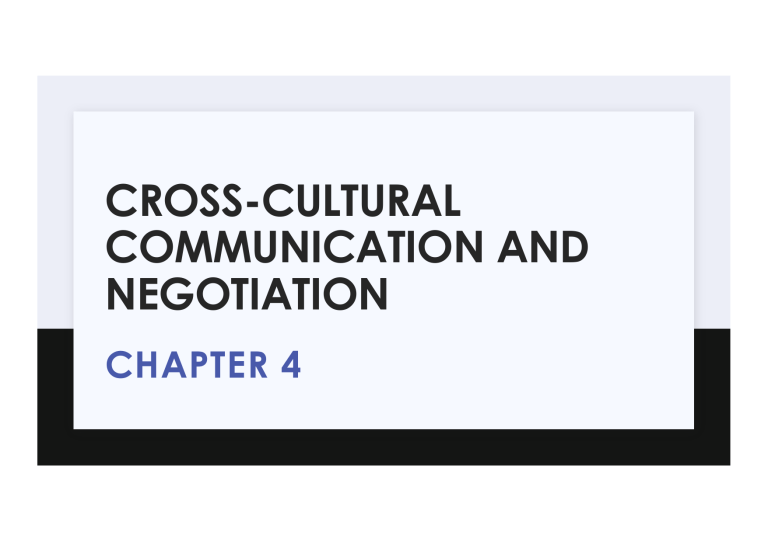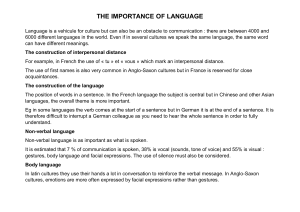
CROSS-CULTURAL COMMUNICATION AND NEGOTIATION CHAPTER 4 A different language is not just a dictionary of words, sounds, and syntax. It is a different way of interpreting reality, refined by the generations that developed the language. -- FEDERICO FELLINI FILMMAKER AND DIRECTOR, ITALY 1. Interpersonal communication TOPIC FOR TODAY: COMMUNICATION ACROSS CULTURES 2. Cultural screens on interpersonal communication 3. Culture, cognition communication 4. Culture and communication protocols 3 WHAT IS COMMUNICATION? Communication describes the process of sharing meaning by transmitting messages through media such as words, behavior, or material artifacts. 4 HOW DO CULTURAL FACTORS PERVADE THE COMMUNICATION PROCESS? “Culture not only dictates who talks with whom, and how the communication proceeds, it also helps to determine how people encode messages, the meanings they have for messages, and the conditions and circumstances under which various messages may or may not be sent, noticed, or interpreted. In fact, our entire repertory of communicative behaviors is dependent largely on the culture in which we have been raised. Culture, consequently, is the foundation of communication. And, when cultures vary, communication practices also vary.” Samovar, Porter, and Jain 5 EYE OF THE BEHOLDER: PERCEPTION AND COMMUNICATION: A STARTING POINT Selective perception: People pay attention to messages that relate to their own immediate problems or needs. Recency effects: A tendency to focus on the most recent message or interaction compared to earlier ones. Consider: Are these significant, of just minor, influences on interpersonal communication? Model of interpersonal communication Person 1 Attention (What do I see or hear?) Person 2 Person 1 Action Interpretation (How should I respond?) (What does it mean?) Person 1 Person 2 Action Interpretation (How should I respond?) (What does it mean?) Person 2 Attention (What do I see or hear?) Communication environment ü Competing massages ü Visual and audible noise ü Interpersonal relationships ü Power distance ü Knowledge distribution ü Attitudes and perceptions ü Pressing needs ü Cultural screens Cultural screens on interpersonal communication Person 1 Attention: What is heard or seen? Interpretation: How it is interpreted? Action: What is the response? Cultural screens: Culturally mediated cognitions Cultural screens: Culturally mediated cognitions Culturally mandated protocols Culturally mandated protocols Person 2 Attention: What is heard or seen? Interpretation: How it is interpreted? Action: What is the response? 1. Culturally mediated cognitions: how CULTURAL SCREENS ON INTERPERSONAL COMMUNICATION people and messages are often evaluated and processed in the minds of senders or receivers alike. 2. Culturally mandated protocols: required behaviors, such as how we construct or shape our messages in way that may be culturally consistent for us but not problematic for our intended receivers. Culture and communication: A model Exhibit. Cultural influences on the communication process 1. Language and CULTURE, COGNITION, AND COMMUNICATION: FOUR ISSUES linguistic structures 2. Selective perception 3. Cognitive evaluation 4. Cultural logic and shared meaning •Language-in-use •Formal or informal language •Native or nonnative speakers • Assuming that others think and act in the same manner that we do •Focusing on immediate demands •Sensing or missing nonverbal messages Language and linguistic structures Selective perception Cultural logic Cognitive evaluation •Attaching meanings to messages •Norm of authenticity 1. LANGUAGE AND LINGUISTIC STRUCTURES Linguistic structures: The manner in which words, grammar, syntax, and the meaning of words are organized and used. Sapir-Whorf hypothesis: Language imposes a structure on our way of thinking that leads to different ways of experiencing the world and, as a result, different worldview. Consider: Fourth floors The fourth floor in an American building is three flights of stairs up. The fourth floor in a British building is four flights of stairs up. The fourth floor in a Korean building often doesn’t exist. Consider: If identifying the fourth floor is so difficult, what happens when we are talking about something really important? Native and non-native speakers Native English speaker speaking English Non-native English speaker speaking English Cognitions: Cognitions” - Thinks in English; no ongoing translations or interpretations required. - Thinks in other language; often must interpret incoming and outgoing messages - Speaks in English as a second language, often with limited vocabulary - Speaks in English, with extensive vocabulary. - Understands subtleties of English language conversations Communication behaviors: Since messages are usually clearly understood, action implications are also clear. - Often lacks sensitivity to subtleties of English language conversations Communication behaviors: Since messages are not always clearly understood, action implications can also be unclear. 2. SELECTIVE PERCEPTION üIs used to choose what to focus on and what to ignore. üPeople make mental choice about what is important, useful or threatening, and focus their mental powers on these particular issues. 3. COGNITIVE EVALUATION: INTERPRETING WORDS AND ACTIONS When people hear or see something, they have a tendency to categorize the information so they can make judgment about its authenticity, accuracy and utility. They try to relate it to other events and actions so they can make sense out of it and know how to respond. à this process is call cognitive evaluation Example: Ø Americans often rely on the isolated properties of people or objects they are examining in order to attach meaning or enhance understanding. à when they see an individual they tend to mentally classify him or her as a man or women, black or white, professional or blue-colar,.. Ø Chinese tend to classify people on the basic of criteria that emphasize relationship and contexts. à they are more likely to see someone first as a member of a particular group, clan or organization. 4. CULTURAL LOGIC AND SHARED MEANINGS Cultural logic: üIs the process of using our own assumptions to interpret the messages and actions of others, thereby inferring their motives and intentions. üProvides people with a system of assumptions about what is mutually known and understood—our common ground. Consider: An 8:00 meeting Canadian sales rep seeks to make an 8:00 appointment with a prospective Brazilian buyer. She assumes the buyer understands that 8:00 means 8:00 sharp (monochronic time), and that buyer agrees to meet at this time. Brazilian buyer agrees to the meeting, but he assumes that 8:00 is only an approximate time of arrival, and might change in response to other pressing issues (polychronic time). He assumes his Canadian counterpart also understands that the agreed upon time is only a rough estimate. Results: Each party has a different logic about the situation; each has different assumptions. At least one—and possibly both parties—risk being disappointed or frustrated when they meet, leading possibly to a poor business outcome. Cultural logic and cross-cultural communication Culture and communication protocols 1. 2. Message content Message context 3a & b. Communication protocols Culturally mandated communication protocol •Family and health issues •Personal wealth •Conversation sequencing • Interruptions • Emotional display • Message content • Message context Appropriate or inappropriate topics for discussion Message formating Acceptable or unacceptable behaviors Conversational formalities •Use of titles •Speaking order •Use of appologies 1. CULTURAL INFLUENCES ON MESSAGE CONTENT üAppropriate topics for discussion: What topics are taboo for discussions? (family? illness? politics?) üAffirmations and rejections: Must you agree? Can you say “no”? (What is the meaning of “hai”?) üOpenness to express opinions: Can you really express your opinions? (speaking to “superiors”? Speaking to “inferiors”?) 2. CULTURAL INFLUENCES ON MESSAGE CONTEXT üOn average, verbal communication only carries about 35 percent of message content in a two-way conversation. üThis suggests that non-verbal communication can be critical in filling in the blanks in a two-way exchange. üCultures can be differentiated based on the extent to which they generally emphasize high or low context in their communication patterns. Culture and message context: High, mid-range, and low High context cultures Mid-range context cultures Low context cultures • Subtle message content • Non-verbal (contextual) are often very important • Medium is often more important than message • Rank of receiver can affect medium and message • Countries: China, India, Japan, Korea • Both verbal and non-verbal communication is often used in tandem. • Medium and message are both important • Most countries fall somewhere within this mid-range category • Countries: Brazil, Canada, France, Morocco, Nigeria • Overt message content • Non-verbal cues often unimportant or ignored • Message is typically more important than the medium • Rank of message sender or recipient may affect message or medium • Countries: Australia, Germany, Russia, USA 2. CULTURAL INFLUENCES ON MESSAGE CONTEXT üFacial expressions: Is it acceptable to show joy or anger? üPersonal space: How close should we stand to one another? üBody language: Is it acceptable to point at someone? If so, how? What are the implications of bad posture? üSecret communication: Do we use secret codes or symbols to convey meaning that others cannot detect? 3A. CULTURAL INFLUENCES ON APPROPRIATE FORMALITIES (COMMUNICATION PROTOCOLS) üOpening a conversation: Who should speak first? Should we be assertive or passive? üEnding a conversation: Who should end the conversation? Is there a formal end or do people just wander off? üPresenting ideas or proposals: Should you present a proposal allat-once or piece-by-piece? üInterruptions and silence: Is it acceptable to interrupt? Are you comfortable with periods of silence? üVocal characteristics: Should you speak fast of slow, loud or soft? 3B. CULTURAL INFLUENCES ON APPROPRIATE BEHAVIORS (COMMUNICATION PROTOCOLS) üApologies: When should you accept blame? How to save your own and other’s face? üDisagreements: How should you express your disagreements? üEmotional displays: is it OK to yell or cry? üFeedback: How (and when) should you provide someone with feedback? üRequests: How do you make a request? MANAGER’S NOTEBOOK: Communicating across cultures: A summary Communication challenges • Language and logic differences • Message content and context • Communication protocols • Technologymediated communication Communication enhancement strategies • Enhance message clarity • Enhance message comprehension • Minimize communication breakdowns Communication outcomes • Improved exchange of ideas • Improved cooperation and job performance • Avoidance of future misunderstandings • Establish basis for future relationships 1. Enhance message clarity ü Message content MANAGER’S NOTEBOOK: IMPROVING CROSSCULTURAL COMMUNICATION ü Language clarity ü Delivery style 2. Enhance message comprehension ü Inquiry ü Advocacy 3. Minimize communication breakdowns MANAGER’S NOTEBOOK: 1. Enhancing message clarity üState message clearly; slow down. üRepeat message using different words, if possible. üBack up spoken message with written materials. üSpeak in the other’s language, if possible. üAvoid using idioms, jargon, or ambiguous words. üConvey message in ways that are not offensive or threatening to others. MANAGER’S NOTEBOOK: 2. Enhancing message comprehension üState your expectations and assumptions clearly. üRestate the positions of all parties during discussions to clarify common understanding. üDeal with questions and concerns as they arise. üBe patient; repeat message as often as needed. üAsk each side to state the other’s position as he/she sees it. üAvoid being so polite or subtle that message context gets lost. üWrite down any agreements of additional information to be sought. MANAGER’S NOTEBOOK: 3. Recognizing and responding to communication breakdowns üObserve body language for signs of distress, anger, or confusion. üBe patient and understanding. Take a break when appropriate. üMentally change places with others, asking yourself how they would respond to what you are saying. üNotice your own reactions to the situation.



